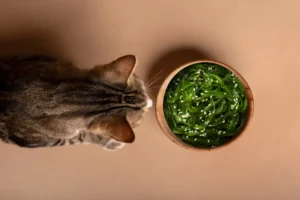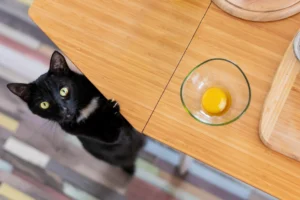Disclaimer: Always check with your vet on what “human foods” your cat can and cannot eat as information may vary based on their dietary needs and health conditions.
Chocolates are a commonly found snack/ingredient in most households as it’s something us humans enjoy. While it’s a no-brainer that chocolates are toxic to dogs AND cats, cats are clever beings that will be able to sneak a bite or pry open a jar of chocolates when no one’s watching.
Table of Contents
Can cats eat chocolate?
No, cats cannot eat chocolate because it’s toxic and can be very dangerous for them. Dark and baking chocolates are more dangerous because of its higher concentration of theobromine.
The toxins in chocolate—primarily theobromine and caffeine—are harmful to cats because they affect their central nervous and cardiovascular systems, which are highly sensitive to these compounds.
Theobromine:
Cats metabolise theobromine much more slowly than humans do, allowing it to accumulate to toxic levels in their systems. Theobromine can cause:
- Increased heart rate and blood pressure, which can lead to arrhythmias (irregular heartbeats) or even heart failure in severe cases.
- Nervous system stimulation, resulting in restlessness, hyperactivity, muscle tremors, or seizures.
- Diuretic effects, which cause excessive thirst, urination, and potential dehydration.
Caffeine:
While caffeine content in chocolate is usually lower than theobromine, it still poses a risk to cats and can exacerbate the toxic effects by:
- Increasing their heart rate and blood pressure beyond the normal ranges
- Causing hyperactivity, muscle twitching, and, at high doses, potentially leading to seizures.
Ingesting chocolate can cause immediate symptoms like vomiting and diarrhoea, but the full toxic effects might not be apparent for a few hours and may take up to 12 hours after ingestion.
If a cat does consume chocolate, it’s important to seek veterinary help as soon as possible.
Symptoms of chocolate poisoning in cats
Chocolate poisoning in cats can vary depending on the amount ingested and the type of chocolate (cocoa powder, dark and baking chocolate being the most toxic, whereas milk chocolate and white chocolate contain a much lower amount)
Symptoms may appear within a few hours and include:
- Gastrointestinal Symptoms: Vomiting, diarrhoea, abdominal pain, excessive drooling
- Nervous System Symptoms: Restlessness or hyperactivity, muscle tremors or twitching, seizures in severe cases
- Cardiovascular Symptoms: Rapid or irregular heart rate (arrhythmias), high blood pressure, panting or rapid breathing
- Other Symptoms: Increased thirst and urination (due to the diuretic effects of theobromine), fever, weakness or collapse in severe cases
If you notice any of these symptoms and suspect your cat has eaten chocolate, it’s best to contact a vet immediately, as chocolate toxicity can escalate quickly.
What to do if your cat ate chocolate
If your cat has eaten chocolate, here are 3 steps for quick action:
1. Keep calm & assess the situation
- Determine how much chocolate your cat ate and what type it was (dark, milk, or baking chocolate; remember that dark choc, baking choc and cocoa powder are the most potent).
- Check for any signs of distress or symptoms of chocolate poisoning.
- Remove the chocolate, but keep the wrapper to show the vet.
2. Call your vet
- Even if your cat isn’t showing symptoms, call your vet immediately. Provide details about the type and amount of chocolate consumed.
- Follow their advice, which may include bringing your cat in for examination.
3. Monitor your cat
- Keep an eye on your cat for any symptoms of chocolate poisoning, such as vomiting, diarrhoea, or restlessness.
Important
Do not induce vomiting yourself as it can sometimes cause more harm than good.
Quick action is crucial, so don’t hesitate to seek veterinary help if you suspect your cat has consumed chocolate!
Treatment of chocolate poisoning in cats
Great job, you’ve gotten your cat to the vet and told them all about what happened! If your cat is diagnosed with chocolate poisoning, the treatment will depend on the severity of the situation and how long ago the chocolate was ingested. Possible treatments may include:
1. Inducing Vomiting
- If the ingestion was recent (usually within a couple of hours), the vet may induce vomiting to remove the chocolate from the stomach.
2. Activated Charcoal
- Administering activated charcoal can help prevent further absorption of the toxins into the bloodstream.
Additional treatments would look like:
Intravenous (IV) fluids
IV fluids may be provided to help flush the toxins from the system, maintain hydration, and support kidney function
Anti-nausea medications
to help manage vomiting
Anti-seisure medications
if the cat is experiencing seizures or severe tremors.
Heart medications
if there are signs of cardiovascular issues.
Monitoring
The vet may want to monitor your cat’s heart rate, blood pressure, and overall condition to ensure there are no severe complications.
In more serious cases, hospitalisation may be required for close observation and treatment. Always follow your vet’s instructions for treatment and care.
How to prevent chocolate poisoning in cats
Keeping their curious paws away from something that could potentially harm them requires several proactive measures such as:
- Store them securely in places your cat will not be able to access. If your cat has the knack of opening cupboards, you might want to consider installing a child-safety lock to protect the goods and the kitty. Same goes to our trash cans, to prevent your cat from scavenging for chocolate or other harmful foods.
- Educate family, friends and your guests on the dangers of chocolate to cats so they will know not to give into their sad kitty eyes or leave their chocolates unattended.
- Read the labels to know whether certain baked goods, candies and snacks contain chocolate and should not be given to your cat. Alternatively, provide cat-safe treats so they don’t feel the need to sneak a bite of potentially harmful human snacks.











